In Part III, we reviewed the significant Fiats of the Vittorio Valetta era, which ended in 1966. This week, we wrap this up with the reign of the founder's grandson, Giovanni "Gianni" Agnelli from 1966 to his death in 2003.
The Years of Giovanni "Gianni" Agnelli 1966-2003
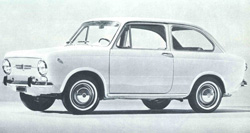
Giacosaís rear engined strategy lived on with the 850 series. Very similar to the 600, the 850 offered 52 hp, but had more weight. The sedan was rare in the U.S.
|
As we have seen, Giovanni Agnelli started, nurtured and built the Fiat Empire from 1899 to his death in 1945. A firm which started out to build large cars for the very wealthy, within 30 years had turned itself around and began producing small cars for the "less well endowed". Fiat had conquered Grand Prix racing in the early 1920s and had pulled out, while providing interesting, competitive cars like the Balilla and 1100 for those who wished to race in events such as the Mille Miglia. Despite the depression and a devastating war, Giovanni Agnelli left a healthy concern to his grandson Gianni. The 24 year old decided to let Vittorio Valetta run the firm until 1966. Valettaís Fiat succeeded beyond the wildest expectations, and by 1967 was the third largest automaker in the world. With the able engineer Dante Giacosa, Fiat delivered a stunning number of new cars in the 1950s which were all financial and critical successes.
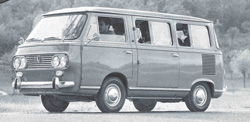
Not seen as often as the 850 spider and coupe, the 1964 850 Station Wagon carried on the Multipla tradition, if not the name.
|
Giacosaís Legacy
Gianniís reign, however, which began in 1966, was troubled, and by the 1990s, the once great automaker was in dire straights. Fiat had become a diversified company, and the auto division was now merely a losing effort which shareholders now wanted to sell. It was an amazing downfall.
For Fiat, it was the age of acquisitions, deal making, diversification and crippling labor and social unrest. It was also during that period which Fiat made an about turn, eschewing the Giacosa inspired rear engined cars and creating a new line of front drive transverse engined cars.
But Giacosaís rear engined legacy lingered in the form of the 850 series, introduced in 1964 as a sedan. Bertoneís attractive sports coupe and spider followed in 1965, as well as the mini-van like station wagon.
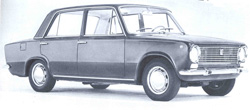
The 1966 124 Sedan, with a robust 60 hp 1200cc OHV engine. It replaced the 1300/1500 line.
|
Abarth did his number on the 850s, but by the end of the 1960s the love affair with rear engined cars was fading. New and much more powerful cars were now available, making the 52 hp 850 look positively anemic. Nor did they have the charm and quality (too much inexpensive plastic) of the earlier 600s.
As Giacosaís legend lived on, so did that of Valetta, who conceived the next generation of Fiats, the 124 series. The 124 was also designed to be built for the Russian market at Togliattigrad, a Russian town named for an Italian communist.
A New Line
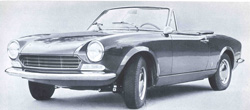
A long lived and successful design, the Fiat 124 started life with 90 hp and 1438cc. It would increase in both size and horsepower as the years went by.
|
The 124 Spider was introduced at the 1966 Turin show, and with it the first DOHC Fiat engine since the 1920s, courtesy of Giacosa and a former Ferrari engineer, Aurelio Lampredi, of the famed Lampredi V-12. The belt drive was new and daring, while the valve adjustment technique had been refined so that the camshaft did not have to be removed to replace the pads.
It was a great car, let down only by quality and quality control.
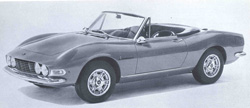
Graceful, powerful, and with a Ferrari based engine, the Dino, was the first Fiat with four overhead cams and limited slip differential.
|
Even better for enthusiasts was the Dino Spider and Coupe, with the Ferrari based Dino engine, 1987 cc with 160 hp on tap. A sure classic, and much appreciated today, the Dinos were well built but suffered rust problems, as did most of the other Fiats. The Dinos would be upgraded to the full 2400 cc by the end of the production run.
The Era of Acquisitons
The engine was part of a deal with Ferrari which would eventually lead to Fiatís first major Italian acquisition. Fiat took control of the production Ferraris in 1969, averting a Ford takeover.
In 1967, Fiat added the attractive 124 Coupe to the already wide range of 124 based cars. The concept was great, the follow through was miserable. Labor problems were on the rise, while cost cutting was evident in every aspect of the car.
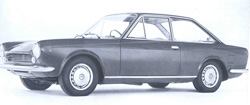
Using the same DOHC engine as the spider, the 124 coupe could carry four adults in a pinch. A five speed gearbox was optional.
|
In 1968, Fiat was at peak production and Fiat had displaced VW as the third largest producer of automobiles. Gianni Agnelli decided to buy Citroen, a deal which cost Fiat millions, and yet strengthened the ailing French company. The deal fell apart by 1973.
A deal to acquire Lancia, however, was more successful. In 1969 Fiat bought out Lancia (because, as Agnelli put it, of "his sense of duty toward the city of Turin") for one Lira per share, plus debts.
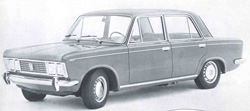
Fiatís efforts at a sporting sedan inspired the 125, an upscale 124 with the 1600cc DOHC engine. Perhaps the nicest of a nice line of Fiats.
|
By 1971, Abarth was purchased by Fiat, and Alfa Romeo in 1986. Only Lamborghini and Maserati remained outside the fold, and eventually Maserati, too, would become a Fiat corporate assett.
More variations on the 124 theme occurred with the 125 Sedan in 1967. A hybrid of the old 1300 floor plan and the new 124 body panels, it was reportedly good for at least 100 mph. At about the same time, BMW was working on the 1600.
Designed to compete with the best Europe had to offer, the 1969 130 was powered by an unusual V-6 engine, similar to the Dino but with single overhead belt driven camshafts. It was larger as well, displacing 2866cc, and producing 140 hp. The 130 had independent rear suspension, automatic transmission, and four wheel disc brakes.
About Face, Again
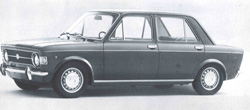
With only 1116 cc and 55 hp, the 128 had to be revved to move but they were almost as much fun as the Minis from which they utilized the transverse engine layout.
|
The year 1969 was also another year of the engineer (whose efforts were doomed to be defeated by the bean counters), as Fiat came forward with the transverse drive, front wheel drive, SOHC 128, a car which was met by great enthusiasm and gained the Car of the Year award. It was brilliant, fun, attractive, and prone to rust quickly. Honda was to introduce the Civic at about the same time the 128 hit the US market.
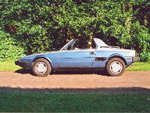
Underated but fragile, the X1/9 was one the last really fun Fiats. Photo Credit: http://www.carsfromitaly.com
|
Another brilliant car was the X1/9, which used the 128 engine sitting transversely in the rear, fortunately in front of the rear axle a la Lamborghini and the Dino 246. With a very pretty Bertone body, the X1/9 was a joy to both see and drive. A very underrated classic, probably because of the reliability and quality issues which plagued it at the time.
Fiat Abarth Rally Cars
Fiatís 131, particularly in Abarth Rallye guise, (400 built) is considered a semi classic today. Highly successful in the WRC, winning the Championship in 1977, 78 and 1980, it had superb performance and well balanced lines. The 131 Rally was a hallmark Lampredi effort. Lampredi had left the Fiat Engineering department in 1977 to take over the Abarth race and rally effort. In fact, the 131 may have been the last significant Fiat ever built. Readers and time will tell.
The Turbulent 70s
In the 1970s, several forces altered the company forever. One, although Fiat would wait until 1983 to close the U.S. distributorships, (taking with it the last of the lamentable Lancias), only the aging 2000 Spider was available in any great numbers from roughly 1975 to 1983. The Brava survived until 1980, and in very small numbers, the Strada, Ritmo elsewhere, dribbled in. Not only would Fiat ignore the worldís largest market, but denied us the chance to experience firsthand the Fiatís produced since that time. At the same time, the Japanese imports were gaining strength throughout the world, cutting into Fiatís slice of the pie. To make matters worse, Italy, and Fiat, were in the throes of a labor revolution and the continued threats and actions of the Red Brigades.
Within the company, the Agnellis, both Giovanni and brother Umberto, were finding that managing the company was no easy task. The Citroen fiasco was followed in 1976 by another, even greater mistake, allowing Libyan dictator Moammar Ghedaffi to purchase a huge number of shares of Fiat, which had both political and economic consequences.
The Romiti Era
By 1980, Agnelli decided to give effective control of Fiat to an aggressive, shrewd and heavy handed Cesare Romiti. As Agnelli stayed in the background, Romiti turned Fiat around in the mid 1980s with cars like the Uno and Panda. By 1987, Fiat again seemed on top of the world, and in 1987 the Tipo was the COTY.
But these were followed by a lackluster series of models. The Croma in 1985, the Tempra in 1990, Cinquecento in 1991, Punto and Ulysse in í94, the Marea and Bravos in 1995-6, most as dreadful as their names. The Stilo was a 2002 effort.
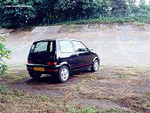
Cute, practical, and yes, still fun, the Cinquecento was nevertheless not a Topolino. Photo Credit: www.carsfromitaly.com
|
Engineering Dilemmas
Insofar as design, the great (and highly influential) designers, Giacosa and Lampredi, were gone. Their successors were hampered by new regulations, a world market, robotic production techniques and cost cutting measures. What Fiat had offered the peasant and the powerful were cars of charm, distinctiveness, a certain panache, and above all, cars which were fun to drive. By the mid 1980s, the vast majority of Fiat products had lost most of these qualities, with perhaps the exception of the new Multipla and the Barchetta. After the purchase of Alfa and Lancia (and Ferrari), Fiat left the production of sporting cars to those groups, so even the new Barchetta in 1995 was a pleasant surprise.
The Future
Romiti was finally replaced in 1998 by Paolo Fresco and most recently by Umberto Agnelli, back again to manage the Fiat automotive group. The future is very uncertain. Many stockholders want to sell off the automotive sector, while GM is trying itís best to get out of the 2004 buyout option. Meanwhile, it is reported that the Agnelli family would like to hold on to Fiat Spa, if only for sentimental (and power) reasons.
It is reasonable to assume that any further Fiat cars of interest will come not from Fiat, but from Alfa, Lancia, Ferrari and Maserati.
But the Italians are always full of surprises.



